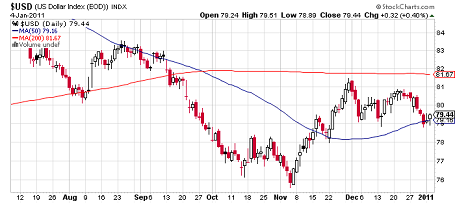A successful investor must be able to be in two
places at once. We must have a firm grasp on what is moving stocks today,
but also have an eye on what will be moving stocks tomorrow.
No doubt this is easier said than done. Because
things don’t always unfold as we expect. And the U.S. dollar’s reaction
to the Fed’s QE2 is a great example of that.
In early August, when the Fed suggested that QE2 was
likely, the result was fairly predictable. The U.S. dollar started
selling off, and stocks and commodities rallied. It was generally assumed
that the falling value of the dollar was being directly applied to the
rising value for stocks, gold, oil, etc.
We discussed this dollar driven rally ad nasueum
here in Daily Profit. And we also took a look at what
the future might look like as a result, as the potential for QE2 to be
inflationary is hard to miss.
******Of course, things don’t always turn out as
planned. Let’s go to the U.S. Dollar Index chart for some visual
help…

Readers will recall the U.S. Dollar Index tracks the
relative value of the U.S. dollar compared to a basket of currencies. The
U.S. Dollar Index is most heavily weighted by the euro.
As you can see, the dollar started falling when the
Fed announced QE2. But when the Fed actually announced its QE2 plans at
the November 3-4 FOMC meeting, the dollar unexpectedly started to rally.
That certainly wasn’t part of the game plan…
*****We should recall that the dollar started to
rally in response to renewed concerns about debt problems in Europe.
Specifically, it was the Irish bank problems that resulted in another
bailout that sparked the dollar’s rally.
One might argue that the European debt issues were
an outlier that messed up an otherwise rock-solid trend for the dollar.
But then that’s the point, isn’t it? New catalysts are always a threat to
a prevailing estimation. And that’s not necessarily a bad thing.
The dollar rally actually makes perfect sense. The
U.S. economy is the most reliable on earth. That may not be saying much
for other economies. But the bigger issue is that we must not let our
preconceived notions about the dollar and the U.S. economy keep us from
recognizing what’s happening and making good investment decisions.
It’s tempting to say that U.S. banks are still
insolvent, the housing market is permanently broken, Federal debt is
crippling the economy and Fed policy is inviting inflation.
But clearly, bearish bets, or even a lack of bullish
bets, have not been productive.
*****We can argue about whether recent improvements
in economic data support current stock valuations. But it’s tough to
argue that we haven’t witnessed a major shift in investor and business
sentiment. We have stepped away form the ledge, people are no longer
staring into the abyss.
Today’s ADP Payroll number showed strong gains in
hiring at small- and medium-sized businesses. And this is where economic
growth always starts.
Will this number translate to a better Nonfarm
Payroll and Unemplyoment Rate (released on Friday)? Well, it hasn’t so
far. In fact, the ADP report has been far better than Nonfarm payrolls,
and the unemployment rate has actually ticked higher.
 Facebook
Facebook
 Twitter
Twitter